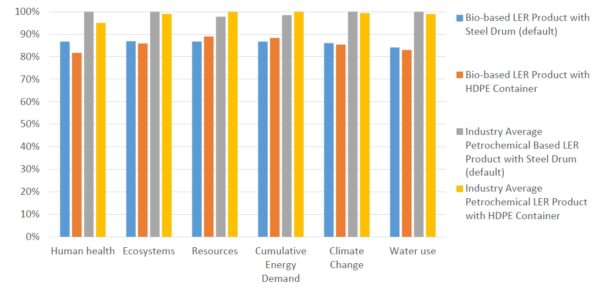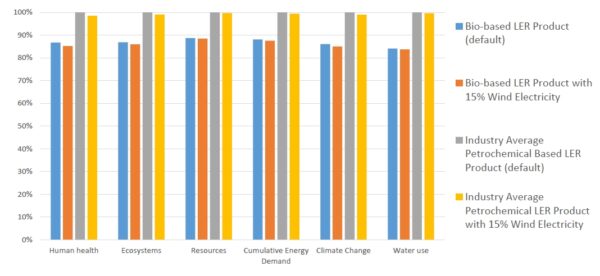Interpretations are the last phase of an LCA, although these are typically done iteratively to inform and refine the goal and scope. In this section, the results are examined based on data quality and consistency. Key assumptions are tested to ensure that conclusions and recommendations are consistent with the goal and scope. It should be noted that the LCA results are based on a relative approach and indicate potential environmental effects and do not predict actual impacts on category impacts.
Key Observations
By analyzing the LER products, the study provides useful insight regarding the environmental impacts, as well as how the bio-based LER products compare to the industry average petrochemical-based LER products. The LCA results and interpretations also identify where the largest impacts are occurring in both products so that Entropy Resins can make further improvements.
Completeness Check
Detailed information on the inputs and outputs of the bio-based LER product was gathered and every effort was made to perform a comprehensive analysis. An attempt was made to include as much detail as possible, even for processes that were found to be largely negligible in the environmental impact assessment. Processes were mass balanced before allocation to ensure all waste and emissions were captured. This was done to ensure completeness. Furthermore, all energy consumption that was understood as relevant for the comparison was included.
Sensitivity Analysis
Sensitivity analysis is performed to understand the influence of variations in the assumptions, methods, and data on the results and interpretations. In other words, sensitivity analysis is used to understand the robustness of the conclusions and identify limitations to the results.
Packing Type
The LER products are packaged in either a 55-gallon steel drum or in a 1-gallon HDPE container. The default scenario uses the 55-gallon steel drum. Results are reduced by 1% – 5% when packaged in a 1-gallon HDPE container.

Renewable Energy
The default scenario uses the average US electricity for manufacturing energy. Entropy Resins sources around 15% of its electricity from renewable sources at its Bay City, Michigan facility. As shown in the image below, when this is applied, the overall results are decreased by 1% – 2% across all impact categories.

Impact Assessment Method

Consistency Check
The compared systems were modeled in a consistent manner. System boundaries for both systems were defined in a similar manner. Therefore, any differences in overall potential environmental impacts should not be due to inconsistent modeling or data.
Next > Life Cycle Assessment Conclusions
View full LCA report from Long Trail Sustainability > US Life Cycle Assessment Report, EMEA Life Cycle Assessment Report
*Long Tail Sustainability is a third-party product stewardship practitioner used to create LCA models for our products that are based on international standards.
